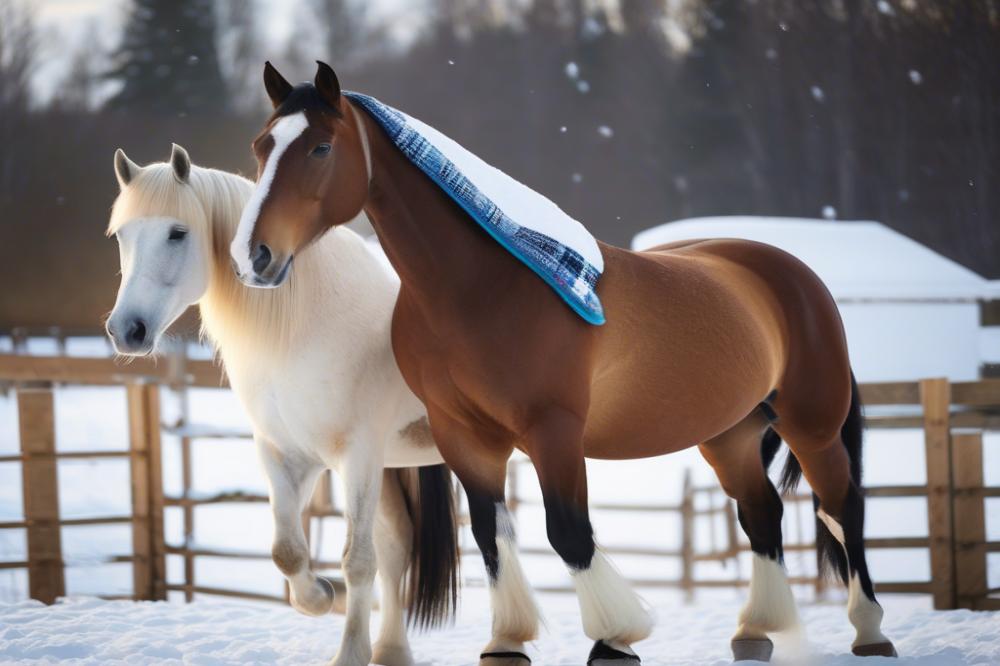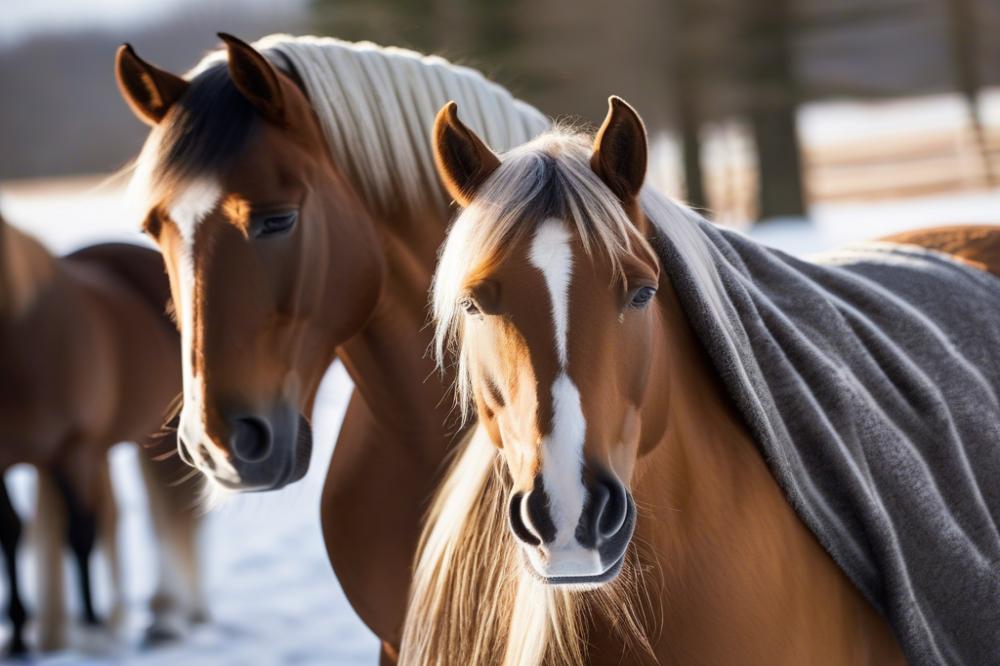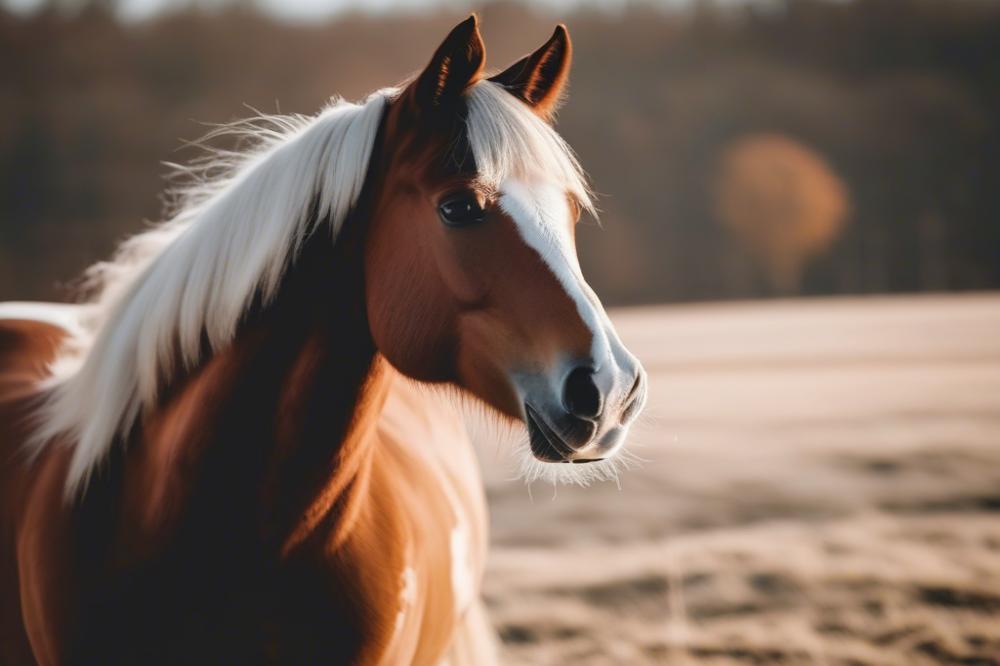Understanding Horse Care
Caring for horses is a bit like being a parent to a four-legged child. It requires attention, knowledge, and sometimes even a good sense of humor. Keeping horses comfortable is not just about feeding and grooming; it encompasses a range of practices that maintain their overall health and well-being. Horse temperature regulation plays a crucial role in this arena, especially as the seasons change.
Why Comfort Matters

People may not know this, but horses have their own way of telling us how they feel. When the weather turns chilly or too hot, their needs shift significantly. Imagine yourself bundled up in a thick coat on a frosty morning—that’s how horses feel on cold days without proper protection. Proper horse care means paying attention to those signals and ensuring our equine friends stay cozy.
Exploring the Concept of Blanketing

Now, let’s talk about the idea of blanketing horses. You might envision a beautiful appaloosa mustang, proudly strutting around in a stylish blanket, but there’s so much more to it than just looks. Horse blankets are used to provide warmth and protection from the elements, especially in winter months. Just like a warm cup of cocoa on a cold day, a good blanket can make all the difference.
During the chill of winter, proper winter horse care becomes essential. Horses can suffer from exposure if left unprotected in harsh conditions. Thanks to blankets, we can help them maintain their body heat while keeping them safe from wind, rain, and snow. A well-chosen blanket not only keeps a horse warm but also provides a layer of safety, preventing conditions like colic that can occur from too much cold exposure.
While some riders might argue that horses are tough enough to endure winter’s chill, there’s a fine line to walk. Balancing a horse’s comfort and health is key. After all, nobody wants to see their beloved steed shivering like a leaf in the wind or, worse, taking a chill that puts a cramp in their riding plans for the big American horse races.
In addition to blanketing, horse grooming remains a vital part of their care routine. Regular brushing not only sheds loose hair but also promotes blood circulation, helping keep your horse feeling great. So, next time you’re preparing your horse for a chilly ride or a competition, remember the crucial connection between comfort, grooming, and everything else that goes into caring for these magnificent creatures.
Understanding Horse Physiology

Overview of Horse Coat Types and Characteristics
Have you ever taken a close look at a horse’s coat? It can be quite fascinating. Horses have different types of coats depending on their breed and environment. Some coats are thick and fluffy, perfect for winter. Others are shorter and sleeker, ideal for warmer months. A horse’s coat can offer protection from rain, cold, and even insects. Grooming plays an important role in keeping that coat healthy. Regular brushing helps remove dirt and loose hair. It also encourages the natural oils to spread, making the coat shine.
How Horses Regulate Their Body Temperature
Horses, just like us, need to keep their body temperatures steady. They can sweat to cool down, and sometimes you’ll see a horse working hard and getting all frothy. During colder months, their natural insulation comes from that lovely coat. Did you know that when temperatures drop, a horse can raise its hair to trap more warmth? This is a clever trick our equine friends use to stay snug. They can even adjust their metabolism to help keep things warm.
Factors Affecting Horses’ Heat Retention and Loss
Several factors can influence how well a horse retains heat. For instance, age does play a role. Younger horses and older horses can have different needs. Body condition also matters. A horse with more body fat might stay warmer than one that is leaner. Environmental factors can’t be ignored either. Wind and rain can chill a horse faster than a chilly breeze at sunset. Additionally, the barn or shelter they stay in, along with their activity level, can make a difference.
During winter horse care, it’s essential to monitor your horse. Do they look comfortable in their environment? You might notice some horses needing blankets when the weather turns frigid. A cozy blanket can help maintain their temperature and keep them from shivering. Learning about horse temperature regulation is vital for good care. Plus, it builds a bond of trust between you and your equine companion. In the end, attentive care helps keep horses healthy and happy!
Reasons for Blanketing Horses
Every horse owner knows that keeping their equine pals cozy and comfortable is part of good horse care. One major reason for using horse blankets is protection from that biting cold winter wind. Horses can feel pretty chilly when temperatures drop, especially if they’re not used to it. Blanketing helps them maintain warmth, just like us bundling up in a warm coat.
Let’s not forget about rain. A wet horse isn’t a happy horse! Blankets keep those equines dry and shield them from moisture that can lead to health issues. When a horse stays dry, it’s easier to keep them clean, too. There’s nothing more delightful than seeing a horse roll in the dirt with a shiny coat after a rainy day!
Light-colored horses, like those pretty palominos or whites, need their fair share of protection from the sun. Sunburns can happen just like they do to us. So, keep in mind that proper horse grooming includes sun protection, especially for those who spend hours outside. A good horse blanket helps provide that necessary shade and prevents that painful burn.
Horse temperature regulation is another key point. Blankets assist in maintaining not just warmth but also the ideal body temperature. The struggle is real for horses to keep cool or warm depending on the season. Using the right type of blanket makes all the difference in their comfort levels.
If you’re gearing up for a show, you’ll want your horse looking its absolute best. Maintaining coat condition before shows is vital. A blanket can help keep that luxurious shine intact while preventing damage from dirt and debris. This attention to detail in horse care can truly set you apart at a competition!
In winter horse care, the decision to blanket often depends on the horse’s age and health. Older horses or those with health issues benefit greatly from a cozy blanket each chilly day. It’s almost like giving them a warm hug—they appreciate it! Every horse is different, just like people, and understanding your horse’s needs is part of the magic of owning one.
Types of Horse Blankets
When it comes to horse care, understanding different types of blankets is crucial. Blankets aren’t just for keeping your horse cozy; they play a big role in horse temperature regulation. Let’s break down the main categories: stable blankets, turnout blankets, and exercise sheets.
Stable Blankets
Stable blankets are great for indoor use. These blankets provide warmth without being too heavy. Horses often wear them while inside stalls. It’s essential to choose one that’s soft and comfortable. After all, comfort matters for horses just like it does for people!
Turnout Blankets
Turnout blankets are designed for outdoor use. They’re usually waterproof and quite durable. These blankets protect horses from rain and snow while allowing them to move. A good turnout blanket has insulation to keep a horse warm during chilly nights. Many include adjustable straps, so getting the fit just right is easy.
Exercise Sheets
Exercise sheets are a whole different ballgame. They are lightweight and usually worn during riding. These sheets can help keep horses warm without overheating. Breathability is key here, as you don’t want your horse sweating under the cover. Often made with moisture-wicking materials, they keep your equine friend dry.
Insulation, Waterproofing, and Breathability Features
When selecting a blanket, think about insulation. How warm does your horse need to be? Some blankets use synthetic materials, while others go for natural fibers. The right choice depends on your horse’s needs and the weather. Waterproofing is another important feature. A good blanketing horse routine keeps moisture out. Nobody wants a horse soaked to the bone! Breathability also matters. If a blanket can’t breathe, it can lead to overheating. Imagine wearing a raincoat lined with a thick blanket; it just doesn’t work!
Materials Used in Horse Blankets
Horse blankets can be made from various materials. Many feature nylon or polyester for durability and water resistance. Some might even use a fill made from synthetic fibers for warmth. There are also cozy options made from fleece. Fleece is soft and warm, perfect for those chilly days post-grooming.
Consider the durability of the material. Horses can be rough on their belongings. Blankets need to withstand some playful kicks and rolls in the mud! Think about how easy it is to clean the blanket too. A machine-washable option can save you a lot of trouble.
Horse grooming and care become smoother with the right blanket choice. Make sure you select a blanket that supports your horse’s size and activity level. Every horse is unique, just like their personality. Whether it’s a rainy day or a cold winter evening, having the right blanket makes all the difference.
Blanketing Practices and Considerations
When to Begin and End Blanketing
Knowing when to use a blanket on your horse can feel like a guessing game sometimes. Start thinking about blanketing as the weather turns chilly. If temperatures drop below 40 degrees Fahrenheit, it’s usually time to consider a blanket for your equine friend. Horses have a great ability to keep warm, but sometimes they need a little extra help. Pay close attention to the conditions outside. Wind, rain, or snow can make the cold feel more intense. If your horse is clipped or has a thinner coat, they might need a blanket sooner than others.
As spring rolls around and temperatures start to rise, it’s crucial to reassess. On warmer days, it’s wise to take the blanket off. Watching for signs of overheating is important. Horses can sweat under their blankets, so keep an eye out for any signs of discomfort. A good rule of thumb: if it’s warm enough for you to wear a T-shirt, consider pulling off the blanket.
How to Properly Fit and Adjust a Horse Blanket
Getting the right fit is vital. A blanket that’s too tight can restrict movement, while one that’s too loose may slide around. When you start fitting a blanket, it should sit just above the horse’s shoulders, and the back should cover the hindquarters without flipping up. Make sure the belly straps are snug, but not so much that you can’t fit a hand underneath. That balance is key!
Adjusting the blanket properly contributes to both comfort and effectiveness. Use leg straps to keep the blanket in place while your horse trots or rolls. It might take some time to get it just right. After a few tries, you’ll feel like a professional blanket-fitter!
Signs a Horse May Need a Blanket or Be Too Warm
Some horses show clear signs that they need a blanket. Look for shivering, standing still, or huddling together with other horses. Those behaviors often mean your horse is feeling the chill. If you notice your pet looking uncomfortable or lethargic, a blanket might be the answer.
On the flip side, horses can also get too hot. If your horse is sweating or restless, it’s time to reevaluate. Feel their body. If it’s warm to the touch and they seem fidgety, they might be wearing too much. Be mindful; a horse that’s too warm can quickly become unhappy.
Blanketing is more than just a trend in equine care. It’s an art. Understanding your horse’s unique needs is part of good horse care and a solid knowledge of horse temperature regulation. Your horse will thank you for it with a grateful nicker and a flick of their tail!
Common Myths and Misconceptions
Many folks have their own ideas about horse blankets and why we use them. Some believe horses don’t need blankets at all. They think horses have fur for a reason. While it’s true that a horse’s coat provides warmth, it’s not the whole story. Just like wearing a coat can help us stay snug, a horse blanket can help our equine friends too.
People often say that blanketing is just a way for owners to coddle their horses. This belief overlooks important facts about horse care, especially during harsh winter months. Horses also get cold, just like us! If a horse is wet or shivering, it may need extra warmth to stay comfortable. Keeping a horse cozy is part of good equine care.
Debunking Myths about Blanketing Practices
Widespread myths sometimes lead to misunderstandings. One common idea is that blanketing is only for pampered show horses. In reality, many horses benefit from blankets regardless of their jobs or lifestyles. Not every horse has good shelter or a thick coat. The weather can be unpredictable, and it’s essential to consider each horse’s needs.
Another misconception is that horses can’t regulate their temperatures if they wear blankets. This isn’t quite right. Good blankets allow for ventilation, so horses can breathe. Think of a blanket as a warm hug. Hugs can be comforting, but they shouldn’t smother you!
Understanding Horse Behavior and Blanketing
Horse behavior often changes with temperature. Some might become restless or cranky when they’re cold. A simple blanket can help calm a chilly horse. Imagine being outside on a frigid day without a jacket. You might not feel like doing much either! Keeping a horse warm may help them be more relaxed and willing to cooperate during riding or grooming sessions.
People sometimes overlook how individual horses react to temperature changes. Each horse is different, kind of like a high school classroom. Some students thrive in the cold, while others prefer it warmer. Monitoring your horse’s comfort level will help guide your blanketing decisions. After all, we want happy horses!
When talking about winter horse care, the right blanket is crucial. A good-fitting blanket should keep a horse warm without causing irritation. Just like your shoes should fit well to prevent blisters, a poorly fitting blanket can lead to problems. Always check for rubs and adjust accordingly.
In the end, understanding these myths can help us take better care of our horses. Look beyond the surface, and you’ll find that blanketing is more than just a trend. It’s about ensuring our horses thrive in any weather. Armed with knowledge, every horse owner can make informed decisions that will benefit their equine pals.
Wrapping Up the Reasons Behind Blanketing Horses
Horses are remarkable creatures, and their care requires a deep understanding of their needs. Blanketing is not just a trend; it serves multiple purposes that benefit both the animal and the owner. From keeping them warm during chilly nights to protecting their coats from dirt and UV rays, blankets play an essential role in maintaining a horse’s health and comfort. Whether it’s the middle of winter or a rainy day, providing that extra layer of protection can make a significant difference.
Caring for a horse involves a lot more than just feeding and grooming. Each horse has its own personality and preferences, which can be as unique as the patterns on their coats. Some might thrive with an extra blanket, while others may prefer to brave the elements on their own. Knowing your horse well makes all the difference. Remember that the choice of whether or not to blanket can depend on factors like age, health, and even breed. And let’s face it, sometimes it’s just nice to see your horse all snuggled up and cozy!
It’s worth noting that those with mules or donkeys in their lives may wonder, “do mules reproduce?” This question is often a topic of curiosity among horse enthusiasts. Just as different animals have their own needs, horse care includes elements like monitoring for certain health concerns. For instance, horse ear plaque can sometimes arise and needs attention.
As we wrap up this discussion, it’s clear that blanketing horses is a reflection of responsible horse care. The comfort of our equine friends should always remain a top priority. Keep in mind, every horse is different, and that’s part of their charm. By paying close attention to their needs and preferences, horse owners show empathy and dedication to their well-being. So, the next time you see a horse in a blanket, know that it’s one of the many ways people work to keep these majestic animals happy and healthy.



